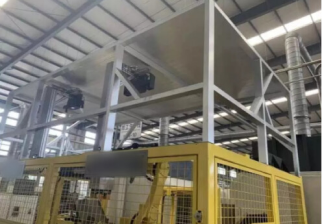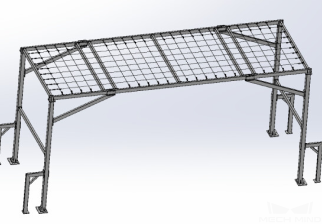Shading Solutions
In manufacturing plants where robots operate, illumination primarily comes from natural light, artificial lighting, or a combination of both. In most cases, shading involves adjusting the factory curtains and modifying or turning off existing lights to meet the operational requirements of 3D cameras.
This section categorizes situations that require shading into three main types based on factors such as lighting methods and workstation layouts. These three categories are also frequently encountered during project implementation.
Skylight Strips on Factory Roofs
This scenario is commonly found in the assembly and machining workshops or factory buildings in the construction machinery sector. These areas are naturally lit during the daytime and supplemented with overhead lights during the night or on overcast days. If the operation continues 24 hours a day, a distinction of lighting between day and night shifts is also necessary.
As shown in the picture below, the left figure shows the lighting effect under natural daylight, and the right figure shows the lighting effect after using a fill light.

The following will introduce the shading solutions of different scenarios with the lighting window on the factory roof.
Scenario 1: Single-Point Shading
-
Description:
There is only one camera at the workstation and the image-capturing position is fixed.
-
Key points for shading:
Block the top light source first. For highly reflective workpieces, the slanting light from adjacent light sources at the top of the workstation should be blocked as well.
-
Shading material:
The shading material should be made of semi-transparent acrylic sheet, and the supporting material can be built with profiles or welded with carbon steel according to the shading area.
-
Shading case:
The figures below illustrate the cases of “full shading on all sides” and “full shading on the top.”
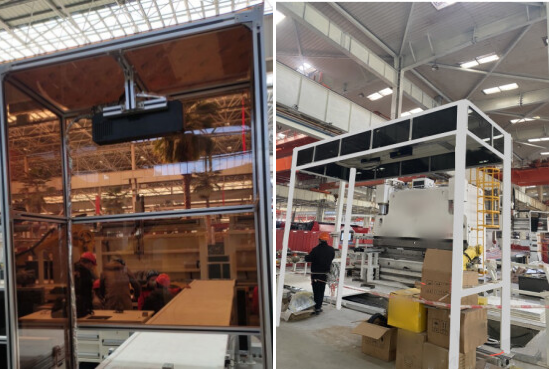
Scenario 2: Multi-Point Shading
-
Description:
Six-axis robot workstation with multiple image-capturing positions. There may be one camera or multiple cameras.
-
Key points for shading:
The shading area should cover all image-capturing positions, including the workstation’s corners affected by slanting light.
-
Shading material:
Semi-transparent acrylic sheets or lightweight fire-resistant fabrics can be chosen as shading materials, preferably using welded carbon steel as a support frame to cover a larger shading area.
-
Shading case:
The left figure below shows a multi-camera workstation, and the figure on the right shows a workstation with one camera mounted on the moving rail. The two shading solutions are different.

Scenario 3: Gantry Robot Workstation
-
Description:
A gantry robot workstation mounted with a single camera capturing images from multiple positions.
-
Key points for shading:
The shading area should cover all image-capturing positions. If there are highly reflective workpieces, it is necessary to shade slanting light as well.
At the same time, since the gantry robot movement area does not allow the placement of shading support columns, it is necessary to consider large-span gantry, overhead canopies, single-pillar cantilever canopies and other forms of shading solutions, which must meet the shading requirements without affecting the movement of the gantry robot.
-
Technical requirements:
-
The support structure should be designed after comprehensive consideration of on-site equipment’s layout and the surrounding environment.
-
The shading framework should be sturdy, streamlined, and aesthetically pleasing.
-
The whole shading equipment should have a small footprint and not interfere with nearby equipment and safety fences.
-
The shading equipment should not hinder the loading and unloading or the overhead crane hoisting.
-
-
Shading material:
The shading material is preferably lightweight fire-resistant fabrics. The support frame can be welded carbon steel or assembled gantry frame according to the actual situation on site.
For side shading materials, semi-transparent acrylic sheets are usually used. By connecting corner fittings through pre-made holes, these sheets can be securely installed onto the support frame. When there are other constraints, curtains made of fully blackout fabrics can also be used. Fabric curtains are easy to disassemble and assemble for future cleaning and replacement. Moreover, they can be equipped with an automatic curtain opener for convenient automated control, as shown in the figure below. The curtain cloth can be installed using the standard method for fabric curtains, with aluminum alloy curtain rails used to secure them onto the support frame. It’s important to minimize wrinkles in the curtains to ensure they maintain a beautiful and elegant appearance without appearing bulky or cumbersome.
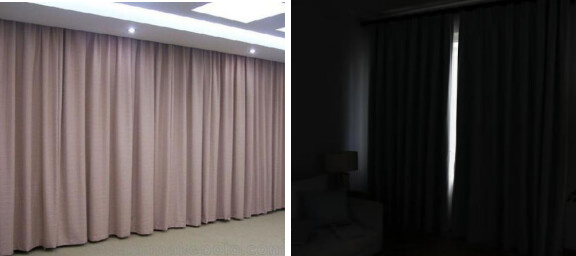
Since the workstation area spans a large area and erected columns are not allowed in the area, there are strict restrictions on the weight of the shading material to block the light on the top. Fire-resistant material can be selected for top shading. This material can save costs, but a supporting structure needs to be laid to prevent the material from collapsing.
For the materials of the support frame, specific recommendations are as follows:
-
The main structure adopts 80 mm×80 mm galvanized square tube.
-
The main structures are connected using 50 mm×50 mm galvanized square tubes to provide support.
-
Ground connection component are made of 200 mm×200 mm galvanized steel plate, which is then fixed to the ground through pre-embedding or anchor bolts, as shown in the figure below.
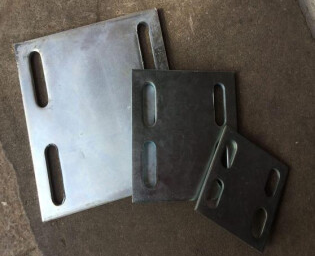
-
The embedded steel expansion bolts need to be fixed on the concrete ground, and then the square tubes are welded onto the embedded parts.
-
Galvanized square tubes and galvanized steel plate embedded parts need to be sprayed with anti-rust paint to avoid rust.
-
-
Shading case:
The left figure below shows the case of shading for the entire workstation and the right figure shows the case of shading for the top of the workstation.

Sunlight Penetrates Factory Side Windows
This scenario is commonly observed in factory buildings with a north-south axis layout. The east and west sides of the building are exposed to slanting sunlight during the morning and afternoon, respectively. Due to factors such as seasonal changes, the intensity of sunlight also exhibits cyclical variations, especially during the summer and fall seasons. On the east side of the factory building, sunlight exposure occurs during the morning; on the west side, it occurs during the afternoon.
The following will introduce the shading solutions of different scenarios with the lighting window on one side of the factory.
Scenario 1: Large Area Glass Curtain Wall
-
Description:
The eastern side of the factory built along the north-south axis features a large-scale glass curtain wall, which is most prone to sunlight exposure during the morning hours.
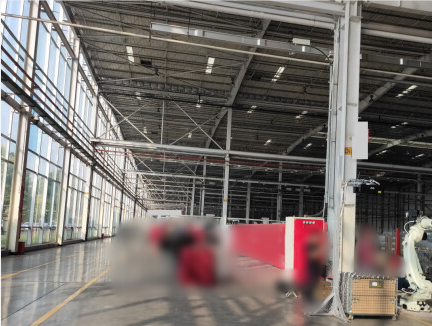
-
Key points for shading:
The film can be applied to the glass curtain wall to solve the problem of shading extremely large areas.
-
Shading material:
The film with different opacities can be selected according to the actual lighting conditions on site. Generally, the semi-transparent film are used, such as the one with 75% opacity.
-
Shading case:
As shown in the picture below, there are two types of film with light-transmitting effects.
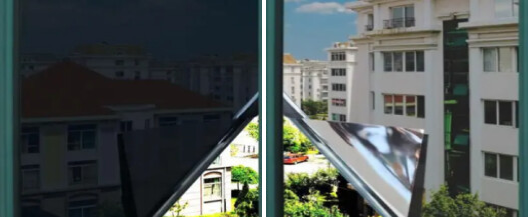
Scenario 2: High-Level Daylighting Windows
-
Description:
The west side of the factory building is severely affected by the slanting sunlight in the afternoon, as shown in the figure below.
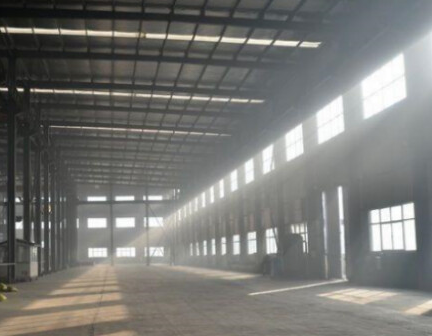
-
Key points for shading:
Block most of the sunlight, avoid direct and slanting irradiation of the workpiece, and create a good lighting environment for the proper functionality of the 3D camera.
-
Shading material:
The shading material can be semi-transparent brown acrylic sheet.
For the frame material, European standard aluminum profiles can be used, connected through built-in connectors, and black sealing strips can be used on the notches of the aluminum profiles.
-
Shading case:
The figures below illustrate the brown acrylic sheet and European standard aluminum profiles used for shading.

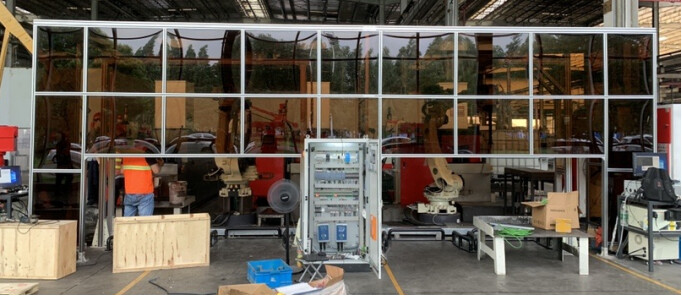
Roof Lighting in Workshops
This scenario frequently arises in cleanrooms and precision machining assembly workshops, such as the defect inspection workshop in the electronic industry, and in the mechanical industry for tasks like engine assembly, motor assembly, and bearing assembly. In these workshops, roof lighting is used exclusively. Different shading solutions are provided based on the form and density of the light sources. The roof lighting arrangement for a specific workshop is illustrated in the figure below.
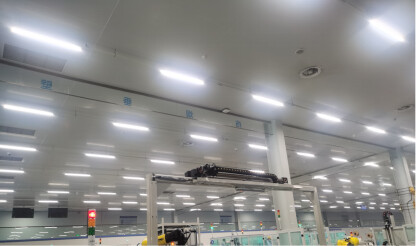
The following will introduce the shading solutions of different scenarios with much roof lighting.
Scenario 1: Partial Shading Layout
-
Description:
There is a continuous lighting above the workstation, which will affect the camera operation when turned on, and partial shading is required at this time.
-
Key points for shading:
Continuous lighting overhead at the workshop interferes with the camera’s operation, so shading is necessary. The shading equipment is installed on the gantry camera stand, which can block the light above and in front of the camera at the same time to avoid the impact of direct and slanting light on the camera.
In addition, when there is slanting light, a solution involving shading on all sides can also be utilized. This maintains the daylighting effect from the top strip, eliminating the need for additional supplementary lights.
-
Technical requirements:
In principle, the shading equipment placed on the camera stand had better be lighter. Large spans and large areas of shading need to be avoided. At the same time, the on-site ventilation conditions need to be comprehensively considered to avoid the camera stand shaking due to wind, which affects the extrinsic parameters of the camera.
Aluminum plates are usually made of two aluminum plates assembled together. At the same time, the aluminum plates should be stacked with a large overlap to prevent light leakage, with the rectangular aluminum plate at the bottom and the L-shaped aluminum plate at the top. In addition, in order to facilitate assembly and transportation, you can also consider cutting oversized aluminum plates into smaller pieces for assembly. The joints of the pieces during assembly must ensure that there is no light leakage.
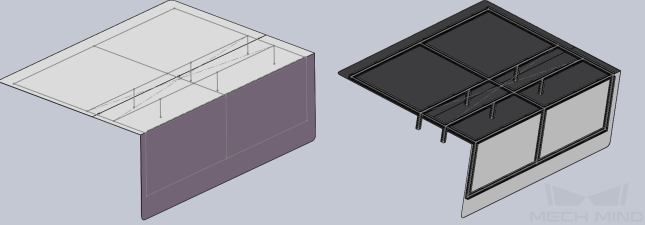
-
Shading material:
For shading materials, the following requirements must be followed:
-
The support frame for shading is built with 40×40 profiles.
-
An anodized aluminum plate can be used for shading on the top. The aluminum plate needs to be bent on both sides and has a thickness of approximately 3 mm.
-
Semi-transparent brown acrylic sheets can be used as side shading panels.
-
-
Shading case:
The figures below shows the cases of shading above the workstation and shading around the workstation.
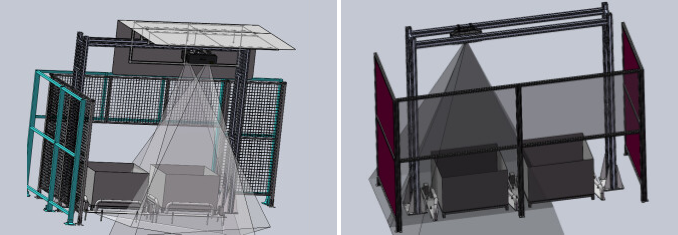
Scenario 2: Small Area Shading Layout
-
Description:
The workstation is located in a compact factory building. There is direct sunlight on one side, and there is a bright LED light on the top at night. At this time, a small area needs to be shaded.
-
Key points for shading:
It is necessary to block most of the sunlight and lights to prevent the workpiece from being exposed to direct light, thereby creating a good lighting environment for the 3D camera to work. At the same time, the shading solution must meet the site layout requirements, especially for factories with a lot of equipment and a relatively compact layout.
-
Technical requirements:
-
The side shading framework integrates with the workstation safety fences, serving as a barrier.
-
Considering the overall layout, determine the foundation bolt-hole positions of the columns to avoid spatial constraints on the workstations.
-
Acrylic sheets are embedded within the slots of the aluminum materials, and the size of the top shading panel is determined based on requirements.
-
The chosen shading material should have an elegant appearance that suits the site’s style and be semi-transparent to meet the client’s requirements for production observation and visitation needs. At the same time, the shading equipment should be semi-transparent to meet the needs of production observation and visits.
-
-
Shading material:
Semi-transparent brown or black acrylic sheets can be used as shading materials. At the same time, the site layout should be considered comprehensively to keep the site color consistent, neat, and beautiful as much as possible.
For the frame material, European standard aluminum profiles can be used, connected through built-in connectors, and black sealing strips can be used on the notches of the aluminum profiles.
For the loading and unloading opening, a semi-transparent soft curtain can be installed to facilitate manual or automatic equipment loading and unloading.
-
Shading case:
The figures below illustrate the usages of semi-transparent brown or black acrylic sheets and European standard aluminum profiles for shading.

Material recommendation
The material selection in the shading solution mainly includes two aspects. On the one hand, it is the selection of shading materials. Choosing appropriate shading materials can meet the camera’s recognition requirements. On the other hand, it is the selection of frame materials that support the shading materials. Only after determining factors such as shading materials, shading range, and workstation layout, can appropriate frame materials and layouts be determined. Other common shading materials are introduced below.
Shading Material
Shading materials include acrylic sheets, fire-resistant canvas, thin steel plates, etc. Different scenarios have different requirements for shading materials. While meeting the shading requirements, they should also meet additional requirements such as low cost, beauty, and ease of assembly. Therefore, these issues should be thoroughly discussed right from the design stage. The performance comparison of common shading materials is shown in the table below.
| Shading material | Aesthetics | Fire resistance | Weight | Ease of construction |
|---|---|---|---|---|
Acrylic sheet |
Overall appearance is aesthetically pleasing |
Not fire-resistant |
Heavy, which will increase the overall weight of the shading equipment |
The frame of the shading equipment requires pre-made mounting holes for installing acrylic sheets, making the construction difficult. |
Fire-resistant canvas |
Neatly laid and beautiful appearance |
Fire-resistant |
Light weight |
Convenient and fast construction |
Thin steel plate |
Thin steel plates are prone to warping and bulging, and they should be coated and painted with the same color as the workstation |
Surface paint materials are not fire-resistant |
Heavy, and more steel needs to be added to the frame of the shading equipment, which greatly increases the overall weight of the shading equipment |
It is necessary to add more fixed points on the frame of the shading equipment for installing steel plates. The assembly is complicated and the construction is difficult. |
Common shading materials will be introduced in detail below.
Semi-transparent Acrylic Sheet
Semi-transparent acrylic sheets provide a certain level of shading effect and are mainly suitable for the top and sides of workstations with small shading areas. Since its material is relatively light, it can be combined with a camera stand or can be quickly assembled with aluminum profiles. It is easy to install and the overall shading equipment can be neat. At the same time, materials of different colors and transparency have different shading effects. The materials are as shown in the figure below. However, it has poor structural stability and is easy to be damaged.
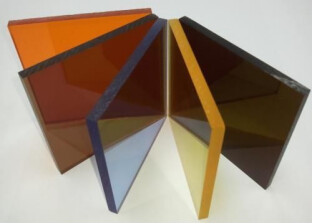
When the semi-transparent acrylic sheet is combined with the camera stand for three-sided shading, the on-site shading solution is as shown in the figure below.

Metal Plate
Common metal plate materials include steel plates, aluminum sheets, etc. They have good molding effects, obvious shading effects, strong stability, and long life. They can also protect the camera to a certain extent. They are particularly suitable for situations where there is overhead crane operation in the workstations. The metal plate are relatively heavy and needs to be supported by a steel structure frame.
In terms of aesthetics, the metal plate can be painted with the same color pigment as the workstation equipment, so that the color of the metal plate and the color of the workstation are harmonious.
The metal plate shading solution is shown in the figure below.
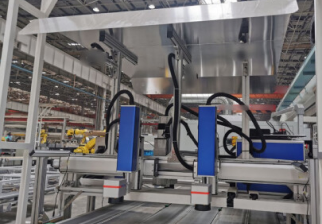
Fire-Resistant Canvas
Fire-resistant cloth has the characteristics of light weight, low price, easy laying, and obvious shading effect. Fire-resistant canvases of different materials and colors can be selected according to the factory environment, as shown in the figure below. Fire-resistant canvas is mainly suitable for large-area shading scenarios. For example, there are 4 to 5 cameras per row in the workstation. The overall shading cost is low. It is often used with an assembled steel structure frame for shading. It is easy to install and low-cost. The disadvantage is that the structure has poor stability and is easy to be damaged.
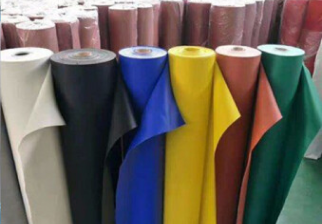
In actual projects, the overall shading solution for multiple workstations is shown in the figure below.
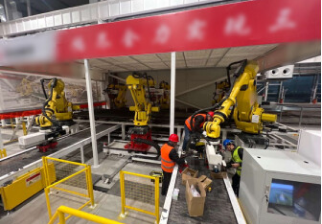
Semi-transparent Soft Curtain
Semi-transparent soft curtains are commonly used in workstations where loading and unloading are frequent. They are placed at the entries and exits for materials, facilitating the loading and unloading processes of AGVs or forklifts. This semi-transparent soft curtains offer significant flexibility but have the drawback of being prone to deformation and damage. Moreover, their flexibility is greatly affected by environmental temperatures.
In actual projects, the shading solution of semi-transparent soft curtains is shown in the figure below.
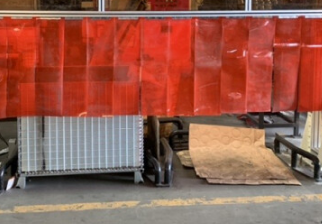
Regular Curtains
While maintaining normal daylighting in the factory, it’s feasible to block windows in areas significantly affected by sunlight. Typically, shading duration fluctuates with the changing angle of sunlight, showing cyclic variations. The regular curtains are typically used in conjunction with electric rails to achieve intelligent control.
In actual projects, the shading effect of regular curtains is as shown in the figure below.
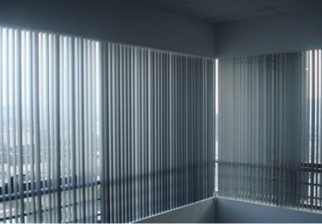
Shading Film
It is very convenient to use shading film for shading. The shading film is usually applied to the windows that have a significant impact on the workstations or to skylight tiles on the ceiling. Since the shading film has a certain impact on the lighting of the surrounding environment, it is necessary to negotiate with relevant personnel whether the effect is acceptable. For example, implementing this solution in large-scale factory buildings with extensive and high skylight tile areas might pose some challenges.
In actual projects, the shading film used is shown in the figure below.
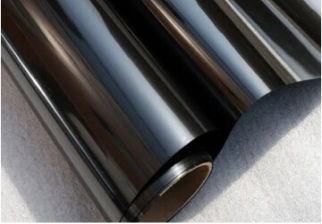
Frame Material
Aluminum Profile Structure
The advantages and disadvantages of aluminum profile structures are as follows:
-
Flexible, easy to install, with standardized accessories.
-
The stability is not good and the cost is relatively high.
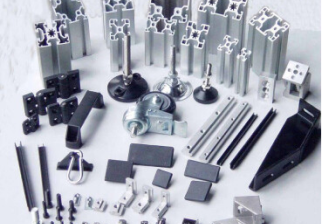
Overall Steel Structure
The advantages and disadvantages of the overall steel structure are as follows:
-
Advantages: Strong stability, low cost, can protect the camera, large shading area, and strong carrying capacity.
-
Disadvantages: requires welding and less flexible.
